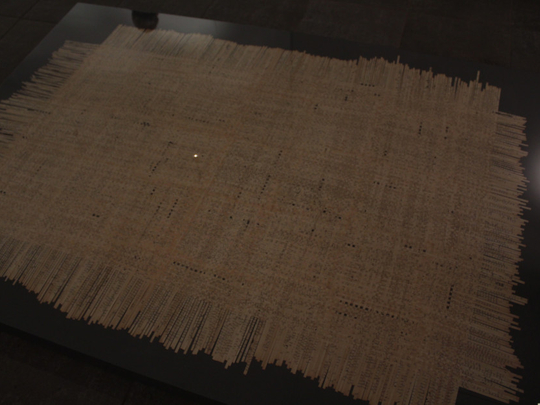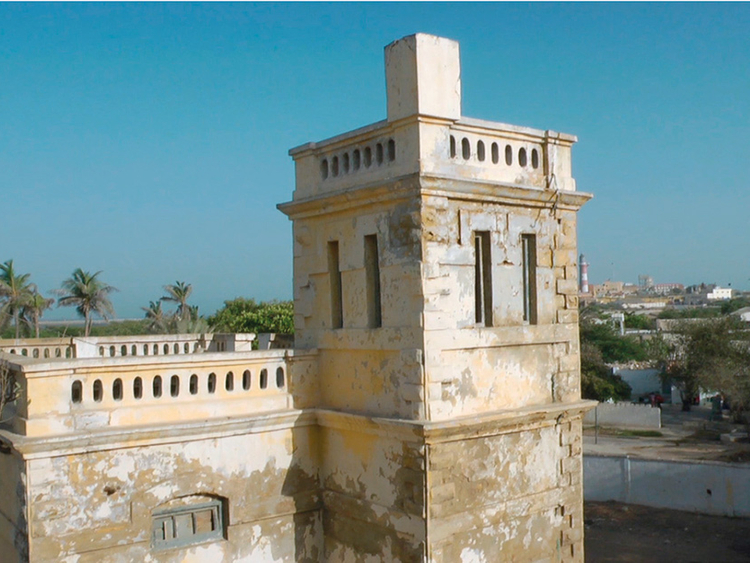
That the sleepless constellation of pain will now sink beneath the sight;
and the bright light will dawn to quell the restlessness of eyes.
These words by legendary Pakistani poet Faiz Ahmed Faiz beautifully convey the pathos of human existence as well as the hope that lifts our spirit and keeps us going. Salima Hashmi, the famous poet’s daughter, who is a well-known artist, art educationist and curator, has taken inspiration from her father’s words while curating her latest show, Sleepless Constellations.
The show features works by seven established and emerging artists, including Pakistani artists, Faiza Butt, Farida Batool, Naiza Khan, Asif Khan, Ghulam Mohammad and Julius John Alam; and young Kashmiri artist, Moonis Ahmad Shah, who has recently graduated with distinction from a prestigious arts school in Lahore headed by Hashmi.
“I felt that my father’s words about the infinity of the cosmos, and the fact that our little lives with all their traumas can still aspire to look up heavenwards and beyond, could be a pivot for bringing together artists whose practices are quite divergent. The artworks in this show revolve around the theme of how one can resolve conflict, memories and histories and create imagined histories and alternative possibilities for a troubled world.
“I believe that only artists can take this leap of faith and put us back in touch with our humanity. At a time when we are weighed down by the images of pain and conflict all around us, these artists through their poetic images are striving to find ways to comfort us and inspire us to feel the limitless cosmos with its sleepless constellations, which will guide us on our journeys towards a better existence. Their works are about imagination, contemplation, perpetual questioning and finding the courage to confront a harsh world. In their own way, each artist illuminates the infinite,” Hashmi says.
The infinite appears in the form of a celestial background in Faiza Butt’s paintings from the series My Love Plays in Heavenly Ways. The London-based artist has created this by hand marbling the surface of the paper using the ancient Turkish technique of Ebru. Her monochromatic black paintings of children playing games on this colourful, cosmic background comment on contemporary society by exploring personal issues such as her own struggle to find the balance between her roles as a mother and an artist; and social issues such as the impact of war and violence on children. A background of stars and heavenly bodies is also seen in her new series of painted ceramics, titled Sleepless Constellations, featuring imagery reflecting on issues such as gender, the human condition and territorial conflicts.
Farida Batool portrays contrasting realities and notions of memory and history in her work by using lenticular prints, where the image changes as viewers move around them. Her work in this show, Yunhi Koi Chalte Chalte (just someone along the way) is inspired by her daily walks along the centuries old canal that runs through her city Lahore, winding its way from the poorest neighbourhoods to the poshest areas. It speaks about unexpected encounters with the many stories of her city. As viewers move around the work, they can see the water flowing and then a piece of paper floating in it. The artist invites viewers to imagine the paper as a letter, using it as a metaphor for the stories of the city’s residents. Jameel Art Prize winner, Ghulam Mohammad, is interested in exploring the relationship between language and identity. The artist from the minority province of Balochistan, has seen his native language disappearing, and his work expresses the fragmentation and confusion people feel on being dispossessed of their language. Using a self-designed loom, he has woven together strips of paper cut from Urdu publications to create a beautiful carpet of scrambled words that make no sense, yet convey strong emotions and feelings. In other works, he has similarly used thread like cuttings of printed texts to create delicate collages as a silent but strong protest, against the hegemony of languages of power.
Lahore-based Julius John Alam’s philosophical works also deal with issues regarding minority communities in Pakistan. His work in the show, Shama Jalti Rahi was created in response to the tragic incident of a Christian woman named Shama, being burned alive along with her husband by a Muslim mob who accused her of blasphemy. To mourn the death of this mother of three, who was pregnant with her fourth child at the time, Alam has made books from the cloth used as a burial shroud and embedded them in plaster, leaving only a red stitch along the spine visible, giving the impression of a stitched wound. For the artist, tearing the cloth and carefully stitching it together was like a sacred ritual and an act of love, and he hopes that joining him in mourning the loss of these lives by reading the empty pages will encourage people to be caring towards others.
Moonis Ahmed Shah, the youngest artist in the show, subtly talks about the everyday realities of life in Kashmir in a visual language that is apolitical, but brimming with irony and sadness. For example, his installation Kashmir ki Sabza Zari (the vegetation of Kashmir) is a small coffin painted with traditional Kashmiri textile motifs, with fresh grass pushing out of the open lid. The work pays tribute to the dead but also speaks about rebirth, regeneration and the courage to overcome challenging circumstances. In another work the artist has created a series of cabinets and filled them with fictitious documents and objects to talk about the fabrication of records to subvert due legal process that is a reality of life in the region.
Naiza Khan, who lives and works between London and Karachi is showing works that are based on her numerous expeditions to Manora Island off the coast of Karachi and her long term research of Karachi’s built structures and its relationship to the sea.
Her video, The Observatory, captures her exploration of the ruins of a lighthouse on the island, which was used as a meteorological observatory during British colonial rule of undivided India. The soundtrack of the video features weather reports from the India Weather Review of 1939, which mentions cities that are now part of two different countries, and references the heavens and the cross currents that cause storms which recognise no borders.
The work talks about the subjectivity of memory, the stormy history of the subcontinent, present political and social realities, and the challenges to the present posed by the past. It is accompanied by a folio of prints based on handwritten ledgers, weather reports, tide tables, and old bookworm infested nautical almanacs that Khan found inside the weather observatory, which speaks about her country’s history and the erosion of the Utopian promises made by its leaders.
Asif Khan’s work also deals with the past and reimagining history. His work Sequel, is a series of film stills, where he has spliced together archival footage from documentaries shot during the last years of the British Raj to create new, startling images that seem to present an alternative history of the region, offering the possibility of reimagining events and relationships that continue to have implications for the people of South Asia.
Khan is also showing two videos, where dramatic images of the moon rising and fading in the sky and of birds in flight, convey the notion of the planets as they continue their eternal journeys, looking down upon our miniscule presence on Earth, inviting viewers to look beyond their constrained, troubled lives, and to dwell on the possibilities contained in our hopes and dreams.
Sleepless Constellations will run at 1x1 Gallery, Al Quoz until April 30.
Jyoti Kalsi is an arts-enthusiast based in Dubai.













